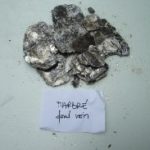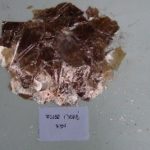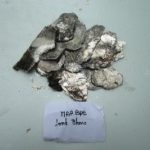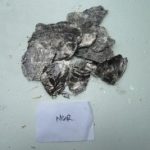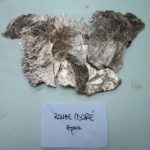Our micas
Mica is a natural, non-metallic mineral that can withstand high temperatures, produces little heat and is flame retardant. It has: good dielectric strength, low dielectric loss tangent angle, resistance to corona arcing, tolerance to water and most chemicals. Natural mica is widely used as an electrical and thermal insulator for its outstanding physical characteristics.
Muscovite and Phlogopite are two types of natural mica that are most commonly used in industry.
Temperature class :
Phlogopite 800 -1000 ℃
The term mica refers to a variety of silicates and refers to a large family of rocks of various colours depending on their chemical composition. It can be white, golden, black, purple. It is then divided into sub-groups known as lepidolite, muscovite, biotite and glauconite.
Due to its technical properties, mica is an electrical insulator and heat resistant. As such, it is widely used in industry and replaces asbestos.
It is also used in ornamentation for its reflections and in the manufacture of cosmetics (natural flakes).

Mica is a general term applied to a group of complex aluminosilicates containing potassium, magnesium, iron, sodium, fluorine and/or lithium. Each member of the group exhibits different physical properties, but all start from flat sixsided monoclinic crystals with a definite cleavage in the direction of the large surface area, which allows them to divide easily into optically flat films as thin as 1 um.
Phlogopite origins
Phlogopite is associated with metamorphosed limestone and ultramafic rocks, particularly hydrothermal veins formed by metasomatism of magnesium-rich rocks as well as carbonatite intrusions of ultrabasic rings and associated with ancient shield zones. MINELCO phlogopite comes from a large deposit in Finland.
Phlogopite specification
Mica phlogopite is a hydrated silicate of magnesium and potassium.
Phlogopite toxicology
Natural non-toxic mineral.
Phlogopite special properties
Mica phlogopite is soft, elastic and strong having high tensile strength, it can withstand substantial perpendicular to the mechanical pressure of the aircraft, but the layering has cleavage so that it can be easily separated into thin, chemically resistant and elastic sheets which are fireproof, infusible, non-combustible and non-flammable. Phlogopite can withstand temperatures up to 900-1000 degrees Celsius.
Mica has a unique array of electrical properties including low conductivity and power loss (high Q-factor), high dielectric strength, dielectric constant and resistivity, uniform capacitance stability, stability under temperature rise, high insulated strength and resistance to arc and corona discharge without permanent injury. While mica is soft, elastic and strong, it is relatively soft. Mica has virtually zero moisture absorption.
Dry ground mica forms a highly delaminated, non-glossy product with a high aspect ratio whereas wet grinding produces thin, flat platelets with a high gloss and good slip.
Dry soil mica is inert, flexible and non-abrasive with finer grades providing brightness (about 75%), suspension properties, insulation and weather resistance; mica reduces chalk, cracking and shrinkage has good lubrication, is elastic and increases strength and tensile and flexural stability.
Adding 4-20% mica to cement and plaster is a cost effective filler and coating agent, as it decreases the apparent viscosity, lowers the cement’s water content and improves resistance to sulphide and chloride corrosion.Mica acts as a reinforcing pigment, reducing penetration into porous surfaces, which improves the mixing and grouting properties of the cement used to fill voids between trowel boards, and to cover nail/screw nicks and other imperfections. Mica is fire retardant, infusible, non-combustible and non-flammable with low thermal conductivity and excellent thermal stability. Mica is used as a substitute for asbestos in thermal insulation boards, fire resistant gypsum boards and precast panels.
Mica Beaux-sol acts as an extender and pigment, reduces checking and cracking, chalk controls, generates a tough shield and promotes adhesion in waterborne and oleoresinous formulations. Mica acts as a reinforcement to prevent sagging and running and acts as a UV and heat barrier, and promotes single layer coverage and long term durability.
Plastic mica contributes to the dimensional stability, thermal stability and insulation, water and gas repellent characteristics, and resistance to UV attack as well as increasing the compression and flexural modulus of the finished product. In particular, mica reinforces RRIM polyurethane to increase the flexural modulus, virtually eliminates warping and generates a superior painted surface. Mica is used in combination with glass fibre to increase stiffness in polyolefin composites. In the rubber industry, mica is used as a mould lubricant, and in foundries as a coating for basic release compounds and mould, mildew and mold remover agents are faced.
The lamellar structure of coarse mica dry soil is used as a loss of circulation material, designed to seal openings and fractures encountered when drilling through porous and fractured rock formations and suspending other solids (oil and gas, water drilling). The lamellar structure facilitates the overlapping of particles to form a layer or wall and acts as a sealing agent that connects openings, so that circulation recovers and retains suspended solids.
Surface treated graduates include pearlescent pigments known for their reflective and refractive properties and their ability to reproduce artificial “mother-of-pearl” or silver-white pearlescent colours through all shades of the arc ranging from a silky sheen to a sparkling shine.


